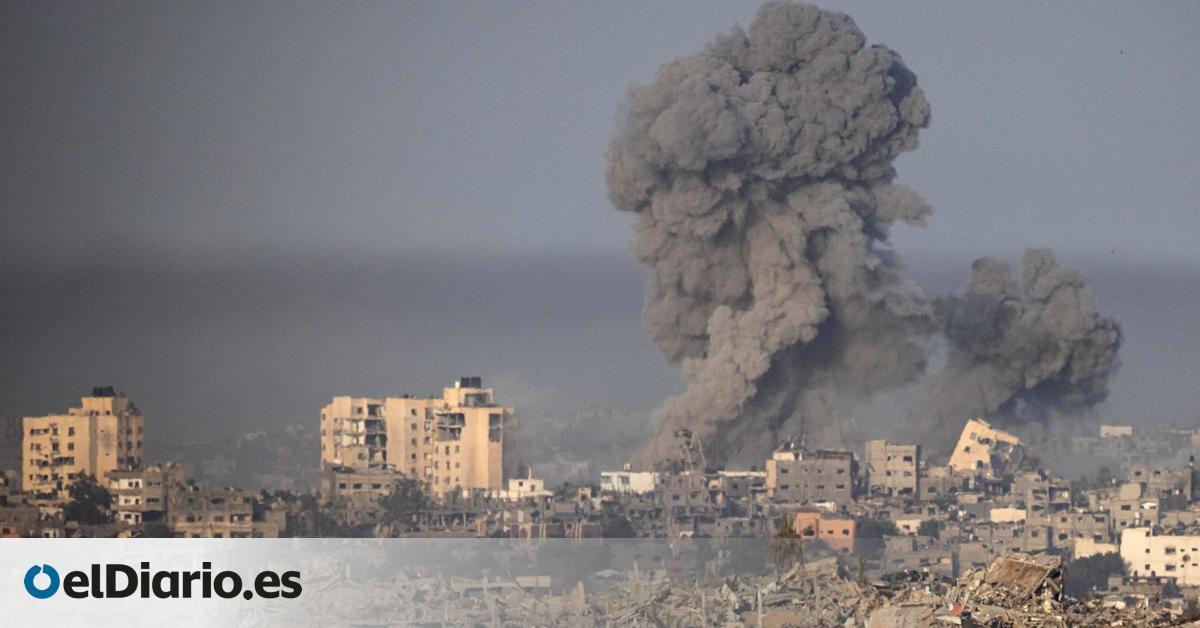
The truce between Israel and the Palestinian group Hamas, reached after weeks of negotiations with the mediation of Qatar, Egypt and the United States, began this morning at 07:00 local time (06:00 in Spain), as announced yesterday the Qatari Government, and relative calm reigns this morning in the Gaza Strip, over which no columns of smoke rise, after seven weeks of incessant bombardments.
About 15 minutes after the ceasefire came into force, the anti-aircraft alarms have sounded again in the Jewish communities near the border with Gaza, according to the Israeli Army, which, for its part, has not stopped attacking targets. in the Strip in the hours before the cessation of hostilities, like every night since the beginning of the offensive – in which more than 14,800 people have died, including some 6,000 children, according to data from the Gazan Government, cited by the UN.
The agreement for a temporary ceasefire and the release of 50 Israeli hostages held by Hamas and other Palestinian militias, in exchange for 150 Palestinian prisoners in Israeli jails, was announced early Wednesday by Qatar and the two warring parties, which They presented it as an achievement and the result of their actions on the ground.
The Israeli Government confirmed that at least 50 hostages – women and children – will be released during the four-day pause in fighting and stated that “the release of every 10 additional hostages will mean one more day of truce”, opening the door to an extension of the cessation of hostilities if Hamas releases more hostages. The Al Qasam Brigades (the armed wing of Hamas) have stated that “for every Zionist prisoner, three Palestinian prisoners will be released, including women and children.”
The Qatari Foreign Ministry reported yesterday that the first group of 13 hostages will be released at 4:00 p.m. local time (3:00 p.m. in Spain) and that they will be “all women and children.” The Foreign Ministry spokesman, Majed al Ansari, explained that the criterion for releasing those hostages first was “purely humanitarian” and that the objective is “to put women and children out of danger as quickly as possible.”
The spokesman said he could not offer details about the process of releasing the hostages or how they will leave Gaza “for security reasons.” “Through our operations room, where we work with the Red Cross and the parties to the conflict, we will ensure that all information is in real time and that everyone receives the correct information so that we can safely bring (the hostages) from one place to another,” he added.
According to Al Ansari, the International Committee of the Red Cross (ICRC) “has been designated to receive the hostages” and will be “an integral part” of that operation, just as it was the previous two times in which Hamas handed over the hostages. this neutral organization four women: an American mother and daughter, on October 20 and, a few days later, two elderly Israeli women.
When the 13 hostages are handed over, Israel will in turn hand over 39 Palestinian prisoners and minor prisoners convicted of terrorism, whose names have already been received by the Israeli Prison Service, according to Israeli Channel 13 cited by the EFE Agency. Hamas has detailed that the terms of the agreement establish that the prisoners be women and minors under 19 years of age, who have spent time in Israeli jails – which would mean that they cannot be those who have been arrested since the beginning of the current conflict, who are already over 3,000, according to the Palestinian Prisoners Society.
It is not the first time that Israel and Hamas have exchanged hostages and prisoners, although on this occasion the Palestinian group has not achieved the release of all the prisoners it wanted. The negotiated ratio is three Palestinian prisoners for one Israeli hostage, much less than the last major exchange, in which Hamas handed over soldier Gilad Shalit in exchange for more than a thousand prisoners. The uniformed man was held captive for more than 5 years, from June 2006 to October 2011, and was returned to Israel, with the mediation of Egypt. Even before the exchange, Hamas had achieved the release of 20 Palestinian prisoners for proof of life of the young soldier, who was kidnapped near the Kerem Shalom border crossing.
Humanitarian aid
Another of the fundamental aspects of the agreement between Hamas and Israel is the entry of humanitarian aid to Gaza, where the most basic goods are scarce after a month and a half of a strict Israeli blockade. Tel Aviv has allowed about 1,500 trucks of supplies to enter since mid-October through the Rafah border crossing with Egypt – up from the 10,000 trucks that used to enter monthly before the war. Since November 18, the Israeli authorities have lifted the blockade on fuel, essential for life in Gaza, and starting today, 130,000 liters of diesel and four gas tankers should arrive in the Strip every day, the authorities have announced. from Cairo. They have also promised the entry of 200 trucks a day with food, medicine and water. For its part, the Israeli Army has highlighted that the fuel and cooking gas are destined for “essential humanitarian infrastructure in the Gaza Strip.”
Shortly after the truce came into force on Friday morning, the first vehicles began to enter through the Rafah land crossing and the administration of this border crossing has reported that a total of 230 trucks will enter on the day of today. But, as Qatar’s Foreign Ministry spokesman admitted yesterday, that aid “will be a fraction of Gaza’s needs,” which have increased as the conflict has caused destruction, hunger and disease.
“A pause of a few days is not enough to address the immense needs after six weeks of fighting, bloodshed and destruction,” said the secretary general of the NGO Norwegian Refugee Council, Jan Egeland, hoping that the truce give way to “a lasting ceasefire.”
“Winter is coming and it would be a disaster to reactivate the conflict. Small shelters house many people, with little food and water, and increasing health difficulties. Children are traumatized and many face a future without their parents and siblings. It needs urgent and long-term help, and this can only be done with a lasting ceasefire,” explained Egaland.
However, Israel has not stopped repeating that the war is not over and that it will resume its military operations and attacks when this temporary truce ends. After its start, an Israeli Army spokesman has asked Gaza residents not to return to the north of the Strip, where troops are deployed and where they have concentrated their ground and air offensive in recent weeks. “The northern Gaza area is a dangerous war zone and movement in it is prohibited. For their safety, they must remain in the humanitarian zone of southern Gaza,” Avichay Adraee has warned in Arabic. He has also warned that they cannot return to the north because it is “very dangerous”, but many of the Gazans who have been displaced to the south by the violence want to return to their homes, to check if they are still standing and their relatives are alive. and to recover your belongings.
A few hours after Adraee’s warnings, Arab television Al Jazeera reported that at least two people were shot dead by Israeli forces as they headed towards the north of the Strip and seven others were wounded. The Arabic channel has indicated that troops are preventing passage to those trying to return to Gaza City, from a checkpoint at one of the entrances to the west of the city.
Some of the displaced have told Al Jazeera that they want to return to their homes to get warm clothes, since winter has begun in Gaza, and many families have taken advantage of the first hours of calm to go from the city of Khan Younis (south ) towards their towns of origin, according to images broadcast live by Qatari television, the only one still present in various parts of Gaza.
Source: www.eldiario.es

